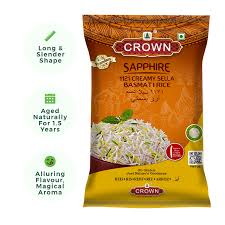Sella basmati rice is one of the most popular types of basmati rice used across the world for its exceptional cooking qualities and versatility. Known for its long grains, firm texture, and rich taste, this rice is a preferred choice in commercial kitchens, hotels, and households alike. It is widely used in biryanis, pilafs, and other rice-based dishes where the grains need to remain separate, aromatic, and flavorful.
In this article, we’ll explore what makes sella basmati rice unique, the different varieties available, its nutritional benefits, and how to cook it to perfection.
What Is Sella Basmati Rice?
Sella basmati rice is basmati rice that has undergone a special parboiling process while still in the husk. The term “sella” means “parboiled.” In this method, the paddy (unhusked rice) is first soaked in warm water, steamed, and then dried before milling. This process hardens the grain, making it less likely to break during milling and cooking. The result is a yellowish or golden grain that turns white when cooked.
This process not only enhances the rice’s shelf life and strength but also helps retain more nutrients compared to regular white rice. The parboiling also makes the rice grains more resilient, which is why sella basmati rice is widely used in bulk cooking for restaurants and catering.
Benefits of Sella Basmati Rice
The popularity of sella basmati rice is due to its many advantages:
- Non-Sticky Texture: The parboiling process makes the rice less sticky, resulting in long, fluffy, and separate grains after cooking.
- High Nutritional Value: Since the rice is steamed in the husk, many of the nutrients from the husk are absorbed into the grain. This makes it richer in vitamins and minerals compared to regular milled rice.
- Strong Grain Structure: It’s less likely to break during cooking, making it ideal for dishes like biryani, pulao, and fried rice where the appearance of the rice matters.
- Long Shelf Life: Sella rice has a longer shelf life than other rice varieties due to its low moisture content after processing.
- Better Absorption of Flavors: The firm texture allows it to absorb spices and flavors more effectively, enhancing the taste of any dish.
Varieties of Sella Basmati Rice
Sella basmati rice is available in several varieties based on the type of basmati grain used and the extent of processing:
- 1121 Sella Basmati Rice: Known for its extra-long grain and excellent elongation upon cooking. This is one of the most sought-after varieties in both domestic and international markets.
- 1509 Sella Basmati Rice: Slightly shorter than 1121 but still long and aromatic. It’s a more economical choice and is widely used in hotels and food service industries.
- Traditional Sella Basmati Rice: This variety offers a nostalgic aroma and flavor that reminds one of old-school cooking, often preferred in home kitchens.
- Golden Sella Basmati Rice: This variant has a natural golden hue due to a specific steaming technique. It’s popular for its unique color and is commonly used in Middle Eastern cuisines.
- White Sella Basmati Rice: Also parboiled but appears white rather than golden. It has the same benefits but a more traditional look.
How to Cook Sella Basmati Rice
To get the best out of sella basmati rice, proper cooking technique is essential. Here’s a simple guide:
- Rinse the Rice: Wash the rice 2-3 times in cold water to remove excess starch and prevent clumping.
- Soak the Rice: Soak the rice in water for 30 minutes to an hour before cooking. This helps in faster and even cooking, and the grains elongate better.
- Boil or Steam: Use a rice-to-water ratio of 1:1.5 for firm grains or 1:2 for softer results. You can use an open-pot method or a rice cooker based on preference.
- Add Flavor: You can enhance flavor by cooking the rice with whole spices like cardamom, cloves, or bay leaves, especially in biryanis and pulaos.
- Rest After Cooking: Let the rice sit covered for 5–10 minutes after cooking. This resting time helps the grains settle and separate beautifully.
Culinary Uses
Due to its strength and flavor absorption, sella basmati rice is widely used in:
- Hyderabadi and Lucknowi Biryani
- Zarda (sweet saffron rice)
- Pilafs and Pulaos
- Middle Eastern kabsa and mandi
- Large-scale catering events and buffets
Its ability to stay firm and visually appealing makes it ideal for food presentation in professional kitchens.
Conclusion
Sella basmati rice is an excellent choice for those seeking premium quality, long grains, and superior cooking results. From its nutritional benefits to its ability to hold flavor and structure, it stands out among other rice varieties. Whether you’re a home cook or a commercial chef, incorporating sella basmati rice into your kitchen guarantees both taste and presentation that satisfy every palate.
As global demand for high-quality rice continues to grow, sella basmati rice remains a top-tier choice in both domestic and international markets.














